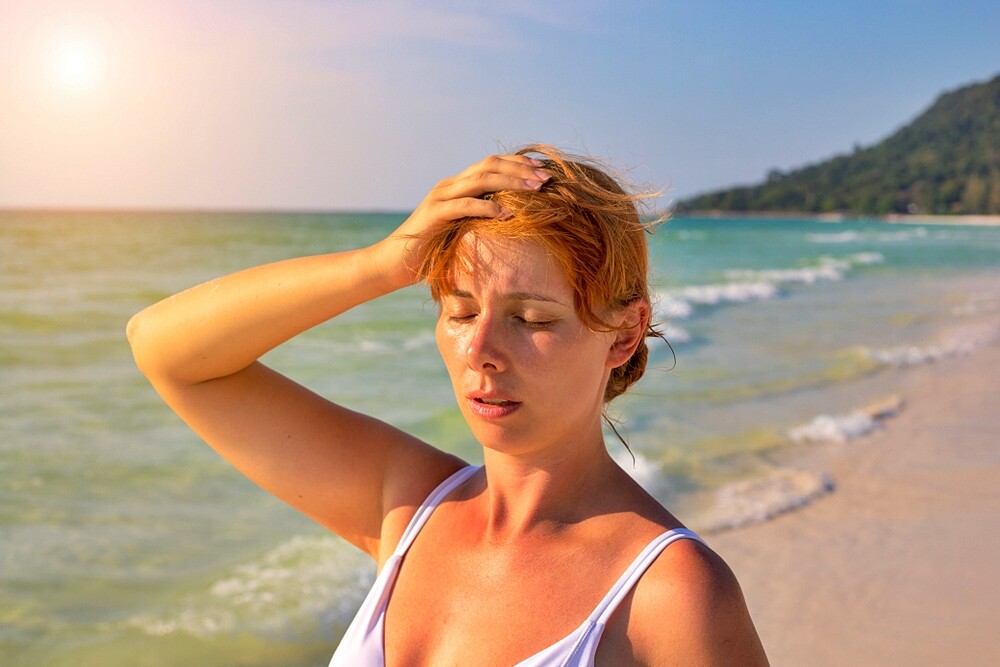A sunstroke occurs when you are exposed to strong sunlight for too long without protection. We explain the symptoms and what helps.
What’s sunstroke?
Sunstroke can occur like heatstroke due to intense sunlight on the head and neck if they are unprotected. This irritates the meninges or brain tissue. Usually sunstroke leads to complaints such as severe head and neck pain and a generally reddened and overheated head. The symptoms are similar to those of heat stroke – but it is even more dangerous. Particularly at risk are people with fair skin and/or no or few hairs, babies, infants, toddlers and senior citizens.
In most cases, the first symptoms appear a few hours after sunbathing. Those affected should then avoid direct sunlight and sit in as cool a place as possible with a raised upper body and head. The head and neck should be cooled with moist towels. If the symptoms are severe or worsen after they were initially mild, a doctor should be called – in the worst case, sunstroke can be fatal.
Typical signs of sunstroke
There are several possible signs of sunstroke. The following symptoms may occur:
- Head is reddened and overheated
- Headaches
- Neck pain / stiff neck
- Nausea
- Exhaustion
- Swindle
- Inner restlessness
- Body temperature normal or at most slightly elevated / children occasionally suffer from fever
In severe cases, additional symptoms are possible:
- Loss of consciousness or circulatory collapse up to coma
- Confusion
- Respiratory disorders
- Vomiting
If these complications occur, an emergency doctor should be called immediately – there is danger to life! The symptoms can cause severe damage to the brain. Attention should be paid to these signs:
- Brain edema: This is when water from the brain vessels passes into the cells, causing the brain to swell. In the bony skull, however, it cannot expand endlessly – the increased pressure can squeeze the brain to such an extent that damage is caused. Those affected usually suffer from severe headaches, appear dazed or listless, have seizures, speech or breathing disorders.
- Disturbances of consciousness or circulation, unconsciousness: Some affected people are restless and agitated, others are confused and apathetic. Unconscious patients should be placed in a stable lateral position. In case of cardiac or respiratory arrest, cardiac massage and respiration are necessary.
- Meningitis: Especially in small children sunstroke leads relatively often to meningitis. If the child complains of rather unspecific other complaints such as abdominal pain, discomfort, sensitivity to light, sounds or touch and has insomnia, this can indicate meningitis. Precisely because the symptoms are difficult to classify, a child should always have a medical examination after sunstroke.
- Heat stroke: Heat stroke can also develop parallel to sunstroke, for example, if the person affected is physically exerting himself or herself in the sun in hot weather and is dehydrated at the same time. Heatstroke is characterised by a fast pulse, low blood pressure and feverish, hot skin all over the body and should be treated immediately by an emergency doctor.
What treatment helps with sunstroke?
The first thing to do in case of sunstroke is of course to avoid the sun and heat and find a cool, shady place. However, since the symptoms usually appear hours later, this measure is no longer necessary in many cases. In addition to the sunstroke treatment, the following should be considered:
- Positioning: Patients should sit with their upper body elevated and also keep their head elevated. This reduces the pressure on the aching head.
- Fluid: In case of sunstroke one is usually dehydrated. If the affected person is conscious and does not vomit, fluid should be given to him/her. Besides mineral water and fruit spritzers, special electrolyte drinks from the pharmacy are ideal.
- Cooling: Cool damp cloths are the best remedy for an overheated head. These should be placed on the head, neck and throat and replaced as soon as they have warmed up. Cool packs are not suitable – the extreme cold only puts unnecessary strain on the body.
The patient must be well observed – the symptoms should slowly regress. In case of complications of any kind, the emergency doctor should be contacted directly. Otherwise, experts advise to refrain from physical exertion after sunstroke and avoid the sun for several days. Also important: We explain heat stroke symptoms here!

